(Editor’s Note: With our state of the Stomach pieces, Culinary Backstreets looks at how – and why – a city is eating right now. This is our latest one for Istanbul.)
On a weeknight near the tail end of March, Istanbul found some clear skies after an annoyingly wet winter. The sky was navy blue, verging on purple, and it was jean-jacket weather, the best kind. Just shy of 10 p.m., we ambled through our most-frequented corner of the Beyoğlu district, the area where Mis, Kurabiye and Süslü Saksı Streets converge. This triangle is home to some of our favorites: Köfteci Hüseyin fires up some of the tastiest grilled meatballs in Istanbul, Zübeyir Ocakbaşı grills skewers of the best lamb money can buy, Müşterek and Meclis offer excellent meze in a warm setting, while Marlen is our favorite place to drown in pints of Tuborg beer or sip reasonably-priced cocktails. That early-spring night, the outdoor tables were mostly full, and would have been jam-packed had it been a weekend.
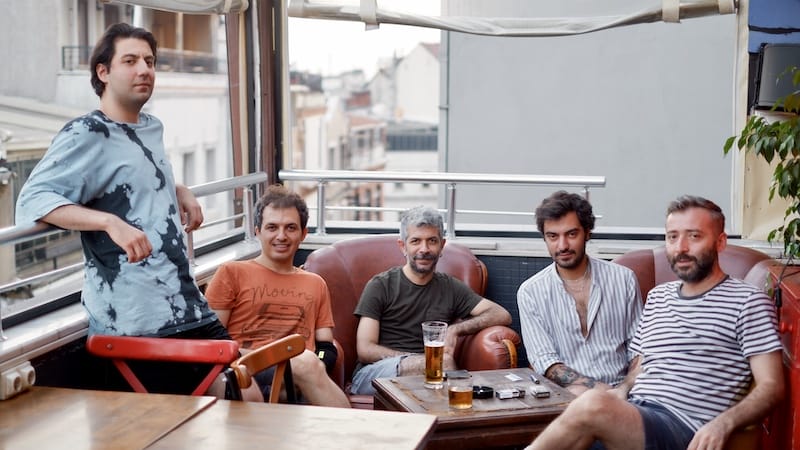
If a city can be described as having a heart, then Beyoğlu is Istanbul’s – the neighborhood has long been synonymous with cosmopolitanism, urbanism, nightlife and tradesmen culture. Like the city, it has undergone rapid changes throughout its history, and the present is no exception. Having struggled for years with a massive influx of capital that transformed much of the area into a shopping-oriented tourist wonderland, Beyoğlu is fighting back harder than ever to maintain its authenticity and spirit, in spite of all odds against an economic and political situation that prefers it resembles one huge, contiguous mall.
For centuries, Beyoğlu’s Taksim Square (taksim means “division” in Ottoman Turkish) distributed water that came from the north to different parts of the city. The historic reservoir stands there to this day – right in front of the giant, shiny new mosque built a few years ago. The reservoir serves as a powerful symbol, with Beyoğlu today still a center for the city’s urban energy and barometer of its mood and well being. As the neighborhood rises and falls – and, like today, rises again – so does the rest of Istanbul.
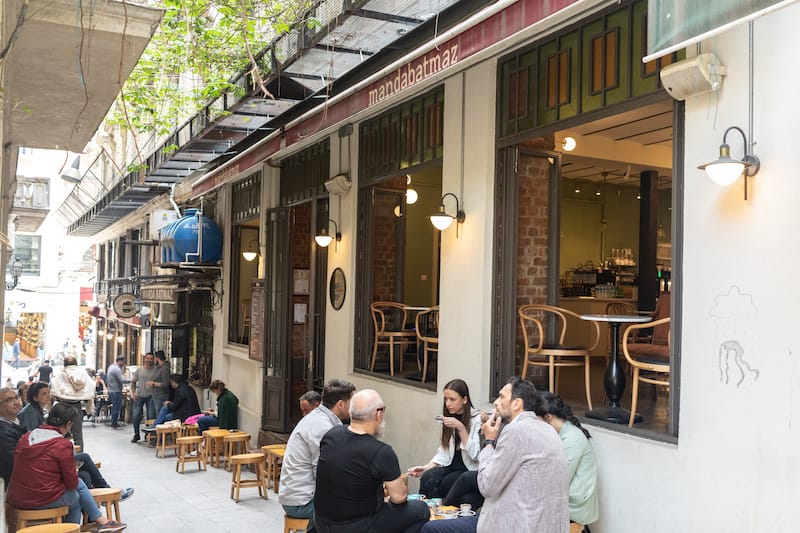
In Beyoğlu and Beyond
As we strolled through Beyoğlu, tables left and right were full of mostly locals and a smattering of tourists, drinking and having a good time. But these days, the specter of inflation looms over every corner of the city. Those who come to Istanbul even for a weekend trip can see the price of their coffee or meal of kuru fasulye go up a couple lira from their Friday arrival to Sunday departure – no matter if it’s the same order at the same restaurant. For the past several years, Turkey has been grappling with a deepening economic crisis characterized by unprecedented inflation that has reached over three digits and the ongoing devaluation of the Turkish lira. While Istanbul may seem cheap for foreign visitors, it is very expensive for locals, who continue to see their purchasing power grow weaker.

To make matters worse, the government, no friend of adult beverages, continues to raise a special luxury tax on alcoholic drinks twice a year. This has resulted in particularly high and perpetually climbing prices of the national spirit rakı, making it more and more difficult for us to seek comfort from all the madness in the pleasantly potent drink – heaven in a slim glass when sipped with meze, green melon and white cheese.
However, in recent years we’ve seen more bars, restaurants and meyhanes opening than closing, not just in Beyoğlu but across the city. It might be a result of that old cliché that these kinds of spots stay full during times of crises, but there is a political angle as well that seems to have worked against what the government is trying to do. Sure enough, the consumption of both rakı and other spirits continues to increase annually in Turkey.
We took this all in as we crossed over to Balo Street, which once was loaded with bars and clubs and was the place to party if you were a student 10-15 years ago. Nowadays, all that remains is a popular Irish pub and a few dodgy establishments with flashy signs and multiple bouncers at the door. Our go-to bar a stone’s throw away recently closed, a neon-pink perfume shop now in its place. We head into Nevizade, among Beyoğlu’s liveliest areas, and the meyhanes and bars there are far from empty. For years, Nevizade reeled from the aftermath of the 2013 Gezi Park protests, where indiscriminate police violence spread to its backstreets numerous times over that summer, causing many to abandon it entirely.
On top of that, a government crackdown on outdoor dining and drinking in Beyoğlu in conjunction with the mass commercialization of the district, which replaced historic small businesses with chain clothing stores and bars with hookah cafés, has drastically changed the area. Many people have declared Beyoğlu dead and have chosen to socialize elsewhere. We have never bought this pessimistic take, and saw growing evidence that the area’s storied nightlife is being revitalized.
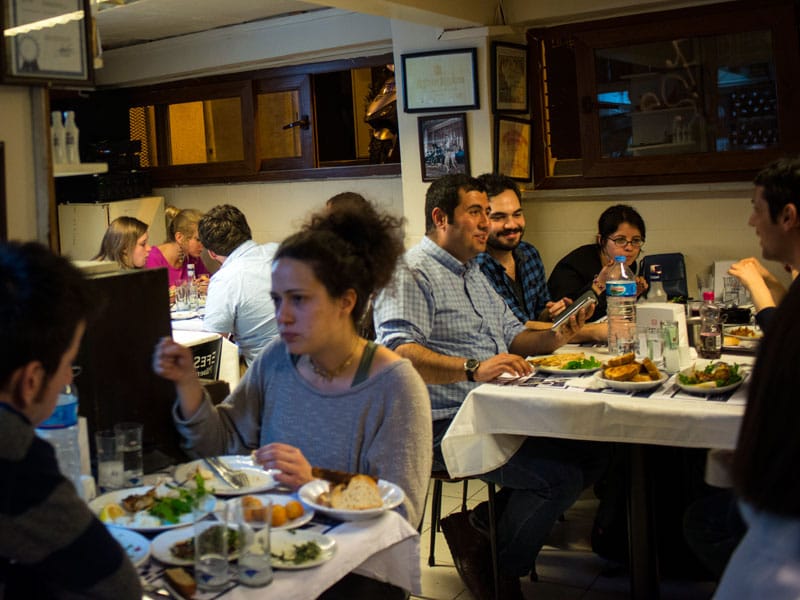
Moreover, the wildly unexpected March 31st local election results saw the ruling Justice and Development Party (AKP) sustain a shocking nationwide defeat, which included ceding Beyoğlu. The district had been run by the party or its predecessor for the past 30 years, but was captured by the main opposition center-left Republican People’s Party (CHP) this time around, providing more hope that a new local government would prioritize the district’s historic and cultural legacy as well as its nightlife and culinary scene over crass commercial development and gentrification.
Crossing Istiklal Avenue, we ducked through Kartal Street. Here, in this alley with its ceiling of ivy hanging overhead, two neighborhood establishments – Urban bar and Çukur meyhane – have managed to stay afloat. Just next door is Sendika, a brand new bar, restaurant and club that is a sleek symbol of the return of Beyoğlu. Decorated sharply with mirrored walls, an old-fashioned bar and elegant lamp posts guarding a winding staircase that leads to a dance floor, Sendika offers a menu of ambitious bar food with a formidable cocktail list. We started with a citrusy bourbon drink spiked with sumac – one of the secret weapons of the Turkish spice arsenal – and found ourselves diving into a spicy fried chicken sandwich and taquitos, of all things. We have not seen them on a menu in Istanbul or anywhere else on this side of the Atlantic, but they came out freshly fried and garnished with cilantro and lime, two ingredients that a few years ago would’ve been hard to come by in this city. Creative people are continuing to take major risks in Istanbul to do something new and different, and it is enriching the dining scene as a result.
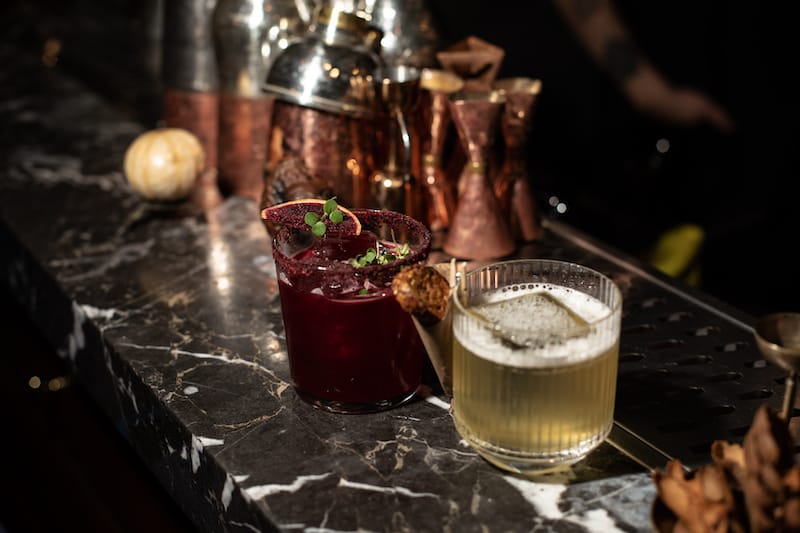
Waves of Change
Even beyond Beyoğlu, traversing our beloved behemoth of a city from corner to corner, we’ve noticed a string of other changes and trends taking hold. We remember barely a decade ago lamenting the difficulty of finding a decent cup of coffee, a solid slice of pizza or a proper burger, and wishing historic neighborhoods like Karaköy’s Perşembe Pazarı – devoid of life after dark – could get a good spruce. We’ve since learned to be careful what we wish for.
When Doğuş Group and Bilgili Holding won the privatization tender for the ultra-luxe Galataport construction in 2013, bars, cafés and restaurants – all impeccably designed but lacking in any real character or soul, and expensive, to boot – arrived on the scene in no time. Spreading all over the city, cookie-cutter burger joints and third-wave coffee shops that probably cost a fortune to decorate grew from irritating to hair-raising reminders that the banality of globalization manifests itself in even subtle signifiers, like red La Marzocco espresso machines and exposed brick.
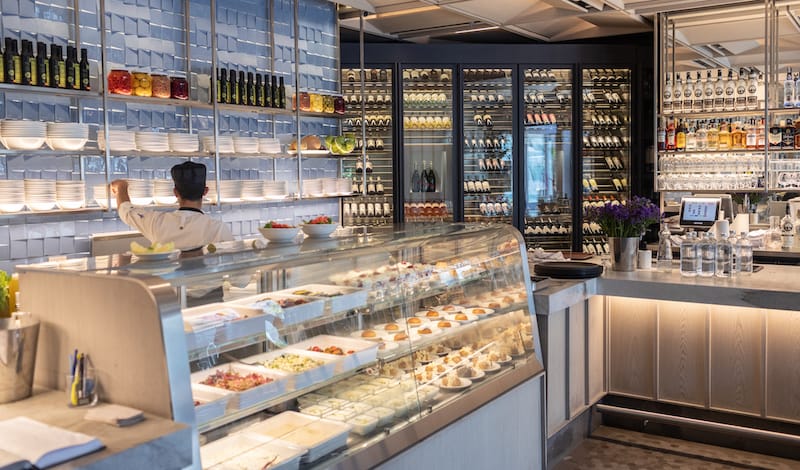
If we’re in Karaköy, it’s likely only to stop into the excellent Karaköy Lokantası, which came long before the uninspiring newcomers we’ve elected to avoid entirely. The restaurant recently moved to another location in the neighborhood with a glitzier, more upscale dining room, but has maintained its combination of high quality without outrageous prices. However, walk through Galataport – a massive $1.7-billion-dollar project that essentially created an expansive seaside promenade flanked by another shopping mall packed with tourists – and outrageous prices will be all you see. After years of delays, the port slow-rolled its opening at the end of 2021. The promenade itself – which is heavily surveilled and can be accessed after walking through metal detectors – is pleasant enough, that is when there aren’t massive cruise ships that have docked alongside it, blocking the exquisite Bosphorus view completely.
But it’s migration, not tourism, that has strongly dictated Istanbul’s foreign food scene over the years, with newcomers making inroads. What began as a flurry of restaurants offering a surprising array of flavors from the Middle East, the Caucasus and Central Asia, and the Far East has now become an established subsect of the city’s cuisine. Many of these places are centered around the Aksaray neighborhood, where we’ve feasted on excellent Georgian, Iraqi, Palestinian, Uzbek, Uighur, Azerbaijani and Russian dishes.
The Fatih district has also become a Little Syria of sorts. The 3.6 million people who have come to Turkey seeking refuge from Syria’s catastrophic civil war over the past decade have left an indelible trace on Istanbul’s food universe, as hundreds if not thousands of Syrian restaurants ranging from stands hawking falafel and shawarma to sit-down restaurants serving Damascene home cooking have become standards across the city. More recently, the Beyoğlu and Şişli districts have seen a surge in the number of down-home restaurants offering the cuisine of Nepal, Thailand, Indonesia and Pakistan, more than welcome additions to the city’s now-international food scene and a tableaux of the new patterns of migration unfolding on the streets.

The World’s Most Dynamic City
Though we’ve witnessed changes both negative and positive, many things remain intact. The city is still a simmering synthesis of delicacies and delights from all over, many of which are within a convenient arm’s length. If we have an inkling for Erzurum’s çağ kebabı, Trabzon’s kuymak, Mersin’s tantuni or Hatay’s humus, we know where to go. On the flip side, it appears that we might be witnessing the last era of the usta, as masters of kebab, köfte and other classic dishes are getting older, with no one eager to replace them when they hang up the apron.
Many of these men were unable to have an education, working their entire lives to ensure a better future for their children. Almost every usta we’ve talked to says that this means their kids won’t be carrying on the tradition. But all is not lost. As with the revitalization of Beyoğlu, folks like former ad-man Cihan Turan are bringing their creative talents to the food world, offering Turkish twists to dishes like the Sloppy Joe at Kurtuluş’s Horo Burger, which is decked out in eighties horror movie and retro video game paraphernalia.
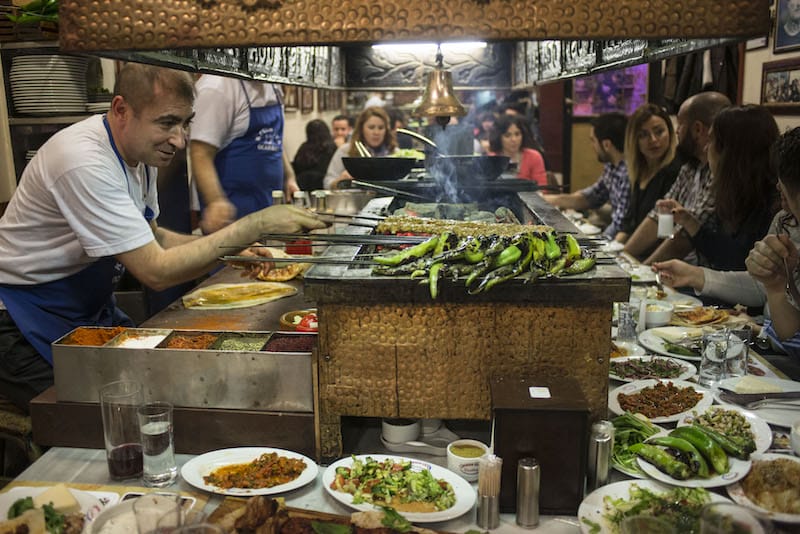
Cool new projects notwithstanding, we’ve been watching warily as the number of hip coffee shops, cocktail bars and restaurants in the historically cosmopolitan Kurtuluş increases slowly but surely. Even mentioning the high cost of rent has reached the point of cliché. But the area’s deeply rooted small-business ethos is holding strong. Walking down the main street and exchanging pleasantries with familiar shopkeepers reminds us of the rich neighborhood culture that thrives here and in so many other places throughout the city, in spite of everything.
And while our pockets have been hit hard by inflation and the constant hikes on booze, we still manage to find ourselves in our favorite meyhanes crowding around a bottle of Prototip and an assortment of the best meze, some of which are so complex and rich in flavor we cannot believe they were made with just two or three ingredients. It is during these moments, when we clink our glasses and smile at one another, that we are happy to be in (what is still) the world’s most dynamic city, able to spend another night indulging in its favorite pastime.
The post Istanbul: The State of the Stomach appeared first on Culinary Backstreets.












